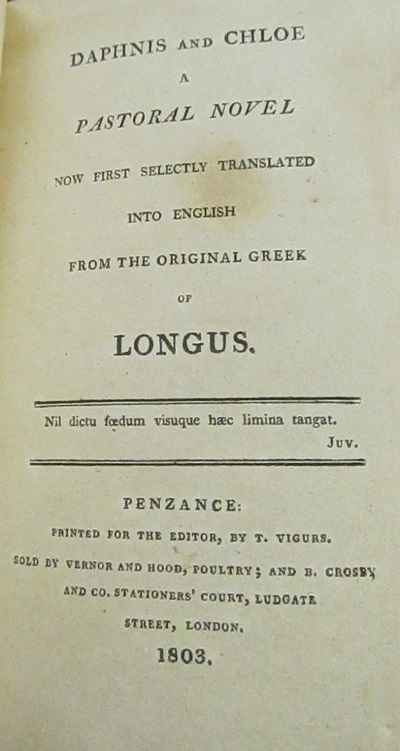
Title page of Longus' Daphnis and Chloe translated by Charles Valentine Le Grice.

Mold on page vi, the largest growth in the book.
Daphnis and Chloe by Charles Valentine Le Grice, 1803.
This book is an 1803 translation of Daphnis and Chloe, a Greek tale by Longus. The translation was done by Charles Valentine Le Grice. Charles Valentine Le Grice (1773-1858) was an Anglican priest who published secular writings along with his translation of Daphnis and Chloe.1 The Latin quote, attributed to Juvenal, is “nil dictum foedum visue haec limina tangat” which translates into English as “Let nothing filthy, either heard by the ear or seen by the eye, enter this threshold.”2 The omission of the last part of the quote would explain that the subject matter of the story is appropriate for all audiences.
The story of Daphnis and Chloe is about two young Greek shepherds who fall in love, but because they are ignorant, do not know what is going on with their bodies. The story follows as the young couple learn about love and how to express their feelings toward each other. It was one of the first novels of the ancient world written in prose and its pastoral style would be emulated by authors in the modern age.3 There is no evidence of Daphnis and Chloe being read in late antiquity as there were no allusions to the story found in other literature contemporary to that time.4 There are two handwritten manuscripts that survived to the Renaissance, one done by Florentinus Laurentianus Conventi Soppressi and a second by Vaticanus Graecus.5 The first post-Renaissance printing of Daphnis and Chloe was performed by Raphael Columbanius in 1598 in Greek.6 Columbanius used Vaticanus’ manuscript only. It was discovered that a portion of the Vaticanus translation was missing, and the missing portion could be found in the Florentinus’ manuscript.7
In regards to this translation, it is fitting for the time period, where much of the more explicit sex scenes, if they weren’t in source material that Le Grice used, are heavily edited or completely omitted. The single text that he used was the edition published by Jean-Baptiste-Gaspard d'Ansse de Villoison in 1778 in Paris.8 Villoison’s translation has chapter divisions that have been used by translators up until the modern age, which makes it easier to compare translations to each other.9 Le Grice claims in his Appendix that he had “never seen any other copy whatsoever.”10 The notes section is limited, and Le Grice states that he “thought that a little volume with any readers, would be preferable to a larger one with few.”11 He claims that he did not want to make his book “resemble the comet-like volumes of the of the present day, whose tails are their longest and most splendid part.”12
Overall, this published edition of Daphnis and Chloe is a rather barebones book, where some translations had illustrations or engravings to accompany the text, this English version was only given quotes from Robert Bloomfield that precede each book of Daphnis and Chloe. Robert Bloomfield (1766-1823) was an English poet.13 Because the book was published in 1803 which was in line with the period’s growing trend in the publication of books that were fiction and intended to entertain readers. The size of the book suggests that it was a personal copy. There is severe foxing on the inner cover that has spread to the first few pages. There also is some mold or mildew growth on the front cover as well. The cover is a full leather, with etching into it.
Even though the book is listed as being Daphnis and Chloe, there is a second book contained within titled Latin and English Poems by a Gentleman of Trinity College, which was later attributed to Benjamin Loveling and Thomas Gilbert.14 There is a marked difference in the quality of this second section, unlike the Daphnis and Chloe section, there are chain lines apparent in the paper. The pages are stiff and do not appear to have been read as much while it was under private ownership. The section was published in 1741 therefore it predates Daphnis and Chloe by sixty-two years. And it had to have been bound with the Daphnis and Chloe after both were in private hands.
Notes
1 Wikipedia, The Free Encyclopedia, s.v. “Charles Valentine Le Grice,” accessed February 16, 2018. ↩
2 Jon R. Stone, The Routledge Dictionary of Latin Quotations: The Illiterati’s Guide to Latin Maxims, Mottoes, Proverbs, and Sayings (New York: Routledge, 2005), 285.↩
3 Longus, Daphnis and Chloe, trans. Ronald McCail (Oxford: Oxford University Press, 2002), xvii.↩
4 Ibid., xxvii.↩
5 Ibid., xxxx.↩
6 Maria Pia Pattoni, “Chapter 37: Longus’ Daphnis and Chloe: Literary Transmission and Reception,” in A Companion to the Ancient Novel, ed. Edmund P. Cueva and Shannon N. Byrne (Oxford: John Wiley & Sons, 2014), 584.↩
7 McCail, xxxxi.↩
8 Wikipedia, The Free Encyclopedia, s.v. “Jean-Baptiste-Gaspard d’Ansse de Villoison,” accessed February 16, 2018.↩
9 Longus, Daphnis and Chloe ed. and trans. Jefferey Henderson (Cambridge: Harvard University Press, 2009), 11.↩
10 Charles Valentine Le Grice, Daphnis and Chloe, A Pastoral Novel Now First Selectly Translated into English from the Original Greek of Longus (London: Penzance, 1803), 246. ↩
11 Ibid.↩
12 Ibid., 248.↩
13 David Kaloustian, “Bloomfield, Robert” Oxford Dictionary of National Biography.↩
14 Latin and English Poems / By a gentleman of Trinity College, Oxford, National Library of Australia, Catalogue. ↩
This spotlight exhibit by Megan Gilbert as part of Dr. Johanna Drucker's "History of the Book and Literacy Technologies" seminar in Winter 2018 in the Information Studies Department at UCLA.
For documentation on this project, personnel, technical information, see Documentation. For contact email: drucker AT gseis.ucla.edu.